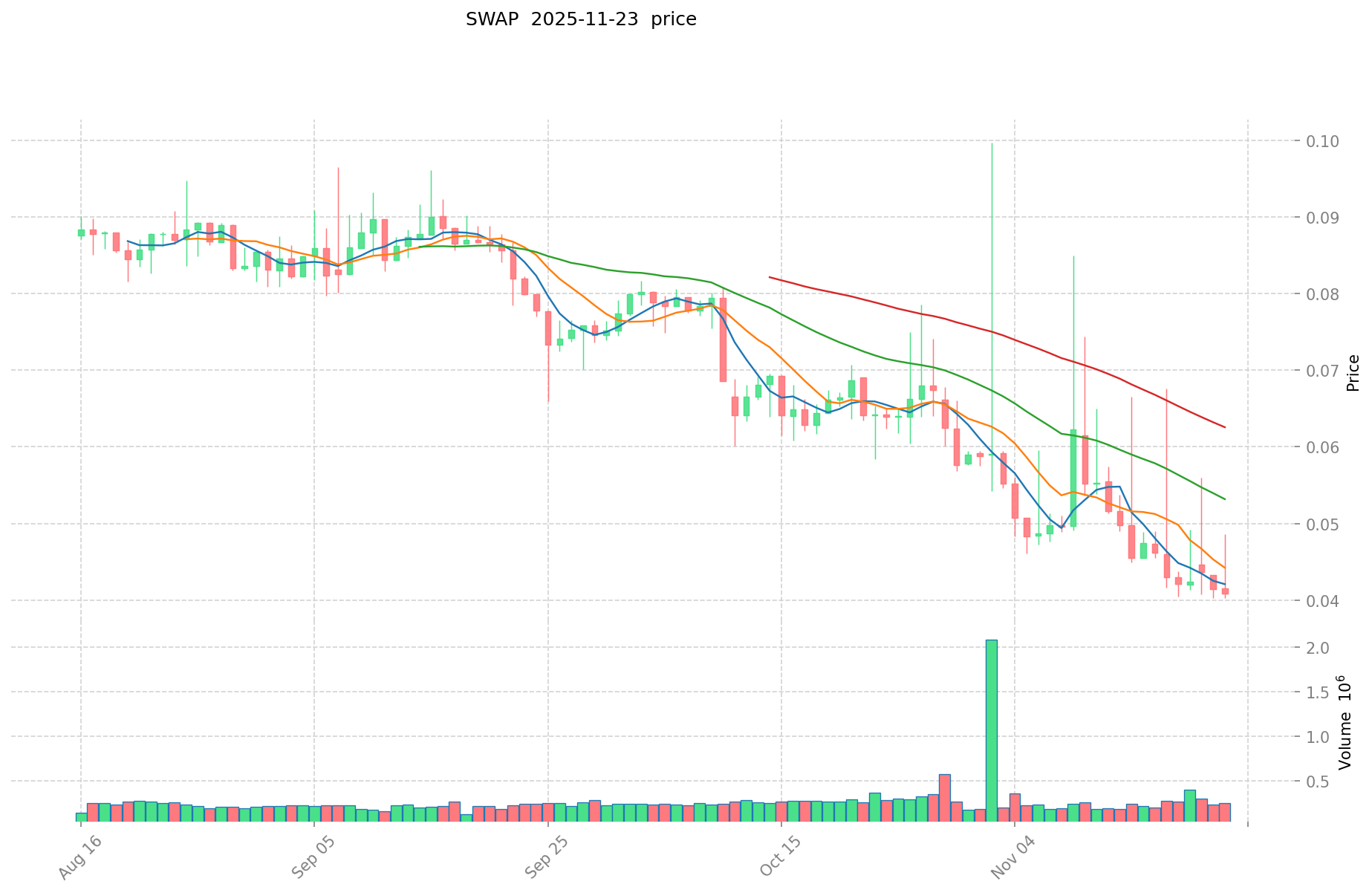What is SWAP: Understanding the Basics of Linux Memory Management
TrustSwap's Position and Significance
In 2020, TrustSwap (SWAP) was launched to address issues such as inefficient fund transfers and lack of automated payment solutions. As a new payment platform, TrustSwap plays a key role in the DeFi and payment sectors.
As of 2025, TrustSwap has become an important player in the automated payment and token swap ecosystem, with 17,685 holders and an active developer community. This article will analyze its technical architecture, market performance, and future potential.
Origin and Development History
Background
TrustSwap was created in 2020 to solve the problem of secure and reliable fund exchanges. It was born during the blockchain technology boom, aiming to change the status quo by providing automated and time-based payment solutions. TrustSwap's launch brought new possibilities for users seeking efficient and secure fund transfers.
Important Milestones
- 2020: Platform launch, enabling automated time-based payments and token swaps.
- 2021: Price reached an all-time high of $5 on April 16, 2021.
- 2025: Continued development and optimization of the platform's features and security.
With the support of its community and development team, TrustSwap continues to enhance its technology, security, and real-world applications.
How Does TrustSwap Work?
Decentralized Control
TrustSwap operates on the Ethereum blockchain, leveraging its decentralized network of computers (nodes) worldwide, free from control by banks or governments. These nodes collaborate to validate transactions, ensuring system transparency and attack resistance, granting users greater autonomy and improving network resilience.
Blockchain Core
TrustSwap utilizes Ethereum's blockchain, which is a public, immutable digital ledger recording every transaction. Transactions are grouped into blocks and linked through cryptographic hashes, forming a secure chain. Anyone can view the records, establishing trust without intermediaries.
Ensuring Fairness
TrustSwap leverages Ethereum's consensus mechanism to validate transactions and prevent fraudulent activities like double-spending. Participants maintain network security through activities such as staking or running nodes, receiving rewards in ETH.
Secure Transactions
TrustSwap uses public-private key cryptography to protect transactions:
- Private keys (like secret passwords) are used to sign transactions
- Public keys (like account numbers) are used to verify ownership
This mechanism ensures fund security, while transactions remain pseudonymous. TrustSwap's smart contract architecture adds an extra layer of security and automation to the payment process.
SWAP's Market Performance
Circulation Overview
As of November 23, 2025, SWAP's circulating supply is 99,996,042.94858491 tokens, with a total supply of 99,996,042.94858491.
Price Fluctuations
SWAP reached its all-time high of $5 on April 16, 2021. Its lowest price was $0.03124961, recorded on July 10, 2020. These fluctuations reflect market sentiment, adoption trends, and external factors.
Click to view the current SWAP market price

On-chain Metrics
- Daily Transaction Volume: $10,190.464357 (indicating network activity)
- Active Addresses: 17,685 (reflecting user engagement)
TrustSwap Ecosystem Applications and Partnerships
Core Use Cases
TrustSwap's ecosystem supports various applications:
- DeFi: TrustSwap platform provides secure and reliable fund exchange.
- Payments: Automated system for scheduled and batched payments.
Strategic Partnerships
TrustSwap has established partnerships with Ethereum-based tokens to enhance its payment capabilities. These partnerships provide a solid foundation for TrustSwap's ecosystem expansion.
Controversies and Challenges
TrustSwap faces the following challenges:
- Technical Issues: Potential scalability concerns on the Ethereum network
- Regulatory Risks: Uncertain regulatory environment for DeFi projects
- Competitive Pressure: Competition from other DeFi and payment platforms
These issues have sparked discussions within the community and market, driving continuous innovation for TrustSwap.
TrustSwap Community and Social Media Atmosphere
Fan Enthusiasm
TrustSwap's community shows activity with 17,685 holders as of November 23, 2025. On X platform, posts and hashtags related to TrustSwap occasionally gain traction. Price fluctuations and new feature releases tend to ignite community enthusiasm.
Social Media Sentiment
Sentiment on X presents a mixed picture:
- Supporters praise TrustSwap's secure fund exchange and automated payment features.
- Critics focus on price volatility and potential scalability issues.
Recent trends show varied sentiment depending on market conditions.
Hot Topics
X users discuss TrustSwap's regulatory uncertainties, integration with Ethereum ecosystem, and potential for disrupting traditional payment systems.
More Information Sources for TrustSwap
- Official Website: Visit TrustSwap official website for features, use cases, and latest updates.
- X Updates: On X platform, TrustSwap uses @trustswap handle, with posts covering technical updates, community events, and partnership news.
TrustSwap Future Roadmap
- Ecosystem Goals: Expand support for Ethereum-based tokens and enhance automated payment features
- Long-term Vision: Become a leading platform for secure and scheduled cryptocurrency transactions
How to Participate in TrustSwap?
- Purchase Channels: Buy SWAP on Gate.com
- Storage Solutions: Use Web3 wallets supporting ERC-20 tokens for secure storage
- Participate in Governance: Stay tuned for potential DAO implementation
- Build the Ecosystem: Visit TrustSwap's developer resources to contribute or build on the platform
Summary
TrustSwap redefines digital currency transactions through blockchain technology, offering secure fund exchange and automated payments. Its active community, rich resources, and unique market position set it apart in the cryptocurrency space. Despite facing regulatory uncertainties and technical challenges, TrustSwap's innovative spirit and clear roadmap secure its place in the future of decentralized finance. Whether you're a newcomer or an experienced player, TrustSwap is worth watching and participating in.
FAQ
What is swap in simple words?
Swap is a quick way to exchange one cryptocurrency for another without leaving your wallet. It's like trading baseball cards, but with digital coins.
How do swaps work?
Swaps allow users to exchange one cryptocurrency for another directly on the blockchain. They use smart contracts and liquidity pools to facilitate trades, offering quick and efficient token exchanges without traditional order books.
What is an example of a swap?
A common swap example is exchanging ETH for USDT on a decentralized exchange like Uniswap. You input ETH, select USDT as the output, and the smart contract executes the trade at the current market rate.
What does swap do?
Swap allows users to exchange one cryptocurrency for another directly, without using traditional exchanges. It provides quick and easy token conversions at current market rates.
Share
Content